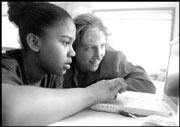IT’S MORNING at the Seattle Girls’ School, and the students are busily putting the finishing touches on a project that will cap the school’s first year: an exhibit at the Pacific Science Center scheduled to open at the end of the week. For the theme of “human improvement,” every student in the tiny private school—31 sixth-grade girls—has come up with an invention to solve a human problem. Jasmine has built a model of a miniature robot that will root around in your arteries cleaning up plaque. Amber designed a machine for regulating air pressure in your ears. And Kayla dreamed up what she calls a “snot knocker,” which is, as she explains, “a little vacuum that sucks your snot into a bag on your arm covered with a fake layer of skin.”
The exhibit is only one way the school has been visible in the past few weeks. It also sponsored local visits by high-profile authors Carol Gilligan, the feminist scholar who made it politically acceptable to say men and women think differently, and Rachel Simmons, who helped launch the current fervor over mean girls (see “Mean Girl Frenzy,” May 30).
Not bad for a school that is so small and unimposing—in an unmarked clay-colored building at Martin Luther King Way and Jackson Street—that you wouldn’t know it was there unless you looked for it. It is, however, a school with big ambitions. Part of a national movement toward single-sex schools, recently sanctioned by President Bush with regulation changes intended to encourage more such schools in the public system, the Seattle Girls’ School plans to grow to 300 students in fifth to eighth grades. It also hopes to become a national leader in curricula featuring hands-on learning that will train teachers from around the country. At the same time, it has made a concerted effort to avoid being another fancy, exclusive private school.
Like many new girls schools around the country, it is a direct result of an onslaught of research published in the early to mid-’90s that raised alarm about girls’ loss of self-esteem as they hit adolescence. As girls begin to feel pressure to conform to stifling notions of femininity, their academic performance drops, especially in math and science, the researchers warned. They said that teachers, unconsciously biased, compound the problem by calling on girls way less often than boys in class.
AROUND THE SAME time that the research came out, Sharon Hammel gave birth to a daughter, Lena. As her daughter grew, the Seward Park mom agonized over the research with other mothers of girls. “We stood on many a soccer field together saying, ‘We’ve got to do something.'”
A high-powered executive at an investment concern, the Frank Russell Company, Hammel decided that a girls school was the answer for those crucial middle years. Since the options were limited (the only girls middle schools were a Catholic school on the Eastside, Forest Ridge, and the tiny Lake Washington Girls Middle School, which accommodated only a dozen or so students), she decided to start one. She recruited into the effort her well-connected stepmother, Karen Lane, a former vice president of the Fred Hutchinson Cancer Research Center.
Along with other supporters, they raised $900,000, including an early half-million-dollar grant from the Bill and Melinda Gates Foundation that allowed them to get a purposeful educator named Marja Brandon on board as head of the school. Brandon, who studied with Carol Gilligan while earning her master’s in education at Harvard University, saw the school as a chance to create what she intends to be a national model of project-based, “integrated” (drawing upon many different subjects) curricula. She also had strong ideas about inclusiveness that jibed with her employers’. To achieve a student body that is half children of color and almost as many on financial aid, they initiated an outreach team that spoke to families in public housing projects, among other places; in one case, they hired an interpreter so they could speak with a girl’s African parents.
By the time the school opened last fall, the nationwide resurgence of girls schools had created some controversy. A 1998 report by the American Association of University Women (AAUW) declared that there was insufficient research to conclude that girls schools improved academic performance by virtue of their gender separation (rather than the resources at these typically small, upper-class schools), and it found that some girls schools actually reinforced outdated notions of femininity. The report was all the more startling for its source; the AAUW helped launch the single-sex school movement in the first place with its 1992 booklet How Schools Shortchange Girls.
At the Seattle Girls’ School, students express mixed feelings about the single-sex nature of their school, which tended to be picked by their parents rather than them. A couple of girls recall problems they had at their previous coed schools.
“I never got to talk to the teachers because they were always yelling at the boys,” says Piper.
Anna says boys were always “rushing in” to perform in science classes, leaving those less sure of their scientific abilities, like herself, unable to say, “Slow down, I don’t know what’s going on here.”
Another group of girls, though, has struggled with the, well, “girly” aspect of the school, as one puts it. They say they were kind of like boys at their old school, playing football, kickball, and basketball. All their friends were boys.
“It’s not as bad as I thought it would be,” says one of these girls, Kayla, the “snot knocker” inventor. But, she says, “You have to accept that some girls aren’t as good at some things [i.e., basketball], and you have to take more time with them.”
Adds Amber, “It’s like we miss our boys.”








